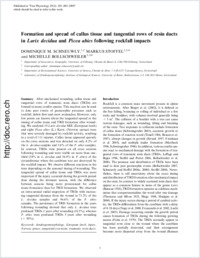Formation and spread of callus tissue and tangential rows of resin ducts in Larix decidua and Picea abies following rockfall impacts
- Schneuwly, Dominique M. Department of Geosciences, Geography, University of Fribourg, Switzerland
- Stoffel, Markus Department of Geosciences, Geography, University of Fribourg, Switzerland - Department of Environmental Sciences, University of Geneva, Switzerland - Laboratory of Dendrogeomorphology, Institute of Geological Sciences, University of Berne, Switzerland
- Bollschweiler, Michelle Department of Geosciences, Geography, University of Fribourg, Switzerland - Department of Environmental Sciences, University of Geneva, Switzerland - Laboratory of Dendrogeomorphology, Institute of Geological Sciences, University of Berne, Switzerland
-
19.12.2008
Published in:
- Tree Physiology. - 2009, vol. 29, no. 2, p. 281-289
English
After mechanical wounding, callus tissue and tangential rows of traumatic resin ducts (TRDs) are formed in many conifer species. This reaction can be used to date past events of geomorphic processes such as rockfall, debris flow and snow avalanches. However, only few points are known about the tangential spread or the timing of callus tissue and TRD formation after wounding. We analyzed 19 Larix decidua Mill. (European larch) and eight Picea abies (L.) Karst. (Norway spruce) trees that were severely damaged by rockfall activity, resulting in a total of 111 injuries. Callus tissue appeared sparsely on the cross sections and was detected on only 4.2% of the L. decidua samples and 3.6% of the P. abies samples. In contrast, TRDs were present on all cross sections following wounding and were visible on more than one-third (34% in L. decidua and 36.4% in P. abies) of the circumference where the cambium was not destroyed by the rockfall impact. We observe different reactions in the trees depending on the seasonal timing of wounding. The tangential spread of callus tissue and TRDs was more important if the injury occurred during the growth period than during the dormant season, with the difference between seasons being more pronounced for callus tissue formation than for TRD formation. We observed an intra-annual radial migration of TRDs with increasing tangential distance from the wound in 73.2% of the L. decidua samples and 96.6% of the P. abies samples. The persistence of TRD formation in the years following wounding showed that only L. decidua trees produced TRDs 2 years after wounding (10.5%), whereas P. abies trees produced TRDs 5 years after wounding (> 50%).
- Faculty
- Faculté des sciences et de médecine
- Department
- Département de Géosciences
- Language
-
- English
- Classification
- Biological sciences
- License
- License undefined
- Identifiers
-
- RERO DOC 11289
- DOI 10.1093/treephys/tpn026
- Persistent URL
- https://folia.unifr.ch/unifr/documents/301100
Statistics
Document views: 169
File downloads:
- bollschweiler_fsc.pdf: 153
